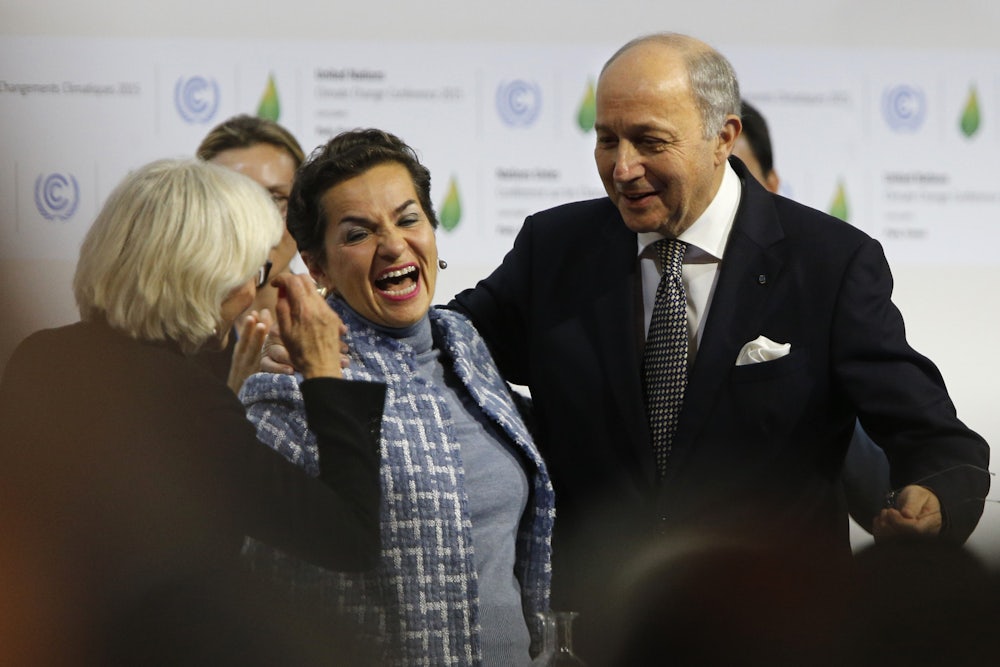“This is a small gavel, but I believe it can do big things,” French Foreign Minister Laurent Fabius said to a cheering room on Saturday, as he marked the adoption of the first truly global climate change agreement.
Minutes before, countries were still fixing typos in the 31-page document, which was cobbled together after an exhausting two-week meeting outside Paris. These negotiations essentially determined the future course of the world. For a long time we’ve needed an agreement that covers the vast majority of carbon emissions and lays out in no uncertain terms that they are on a long-term downward trajectory. But to get there, 195 countries had a decision to make: Would they allow individual disagreements to lock the planet into a future of unrestrained warming, or would they make the hard choices necessary to chart a safer path?
While the Paris agreement is far from perfect, the text as a whole makes a convincing case for hope. The world is a little less doomed now.
Based on the domestic pledges made by 187 countries, covering some 95 percent of global emissions, the Earth’s average temperature could now rise by somewhere between 2.7 to 3.5 degrees Celsius over the course of the century. That’s still far too high, and shows how much work remains, but it is an improvement over the path of unrestrained pollution we were on before Paris.
The agreement still includes many of the aspirational and largely empty promises that are so familiar to the global approach to climate change. It calls for keeping temperatures “well below” 2 degrees Celsius and urges governments to “pursue efforts” to limit temperature increase to 1.5 degrees—a victory for environmentalists and vulnerable nations who will feel the effects of climate change the most. The deal also calls for emissions from developed nations to peak “as soon as possible,” while developing nations are allowed more flexibility.
But such ambitious targets will be meaningless without more specific and aggressive policies to meet them. It’s the mechanisms for implementing the agreement that matter most. No one expected the Paris talks to fix climate change immediately. As the European Union’s climate chief Miguel Arias Canete put it on Saturday, “Today we celebrate. Tomorrow we have to act.”
The first way to do that is by ramping up climate finance. Finance was never an easy issue to settle, and that’s why much of the text on the issue was removed from the legally binding portion of the agreement, in order to allow more flexibility.
Developed nations did agree to a legal obligation to help developing nations adapt to climate change and reduce their emissions. The deal also widened the base for who provides support, somewhat, by encouraging developing nations that can to contribute to do so as well. Recognizing $100 billion a year annually in global finance on climate change as a floor, and not the status quo, was something vulnerable, developing nations wanted to see a strong commitment on. But the final deal punted on that issue, instead saying that nations will return again before 2025 to agree to a new level of finance.
Another important element is the inclusion of a transparent and consistent review process to ramp up pledges in the near future. Without something like a five-year review, the world would be locking in rates of 3.5 degrees Celsius or higher—which would mean an unpleasant future for all. And the final agreement did strengthen how this works, compared to earlier drafts. The first revisiting of 2025 and 2030 goals will come in 2018, with another stock-taking review in 2023. Every five years from there the world will meet to hopefully ramp up pledges indefinitely.
Transparency is key to making sure all this remains on track, with countries reporting their emissions accurately. But nations like China resisted imposed rules for transparency, so the deal allows for “built-in flexibility.” For the first time, though, it does require all nations to regularly report on their emissions breakdown by source, just in a “non-intrusive” way.
In the end, Paris did about what was expected. It didn’t actually create a future in which the world stays well below 2 degrees. Nor did it truly address the fate to which rich nations have doomed small, vulnerable ones—inclusion of the 1.5 degree goal and a mention of “climate justice” was a gesture, but rich countries refused to pay for loss and damage caused by climate change.
One thing you’ll hear a lot of in coming weeks is that Paris will send “signals” and “create momentum” toward further climate action. While such statements may sound like vague talking points (and they are), they also capture how important the coming months and years will be to determining the conference’s success. Paris was a solid start.
